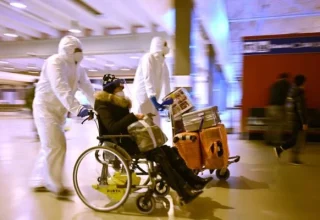ISLAMABAD, June 05 (ABC): Male and female bodies are physiologically different in more than one way — from hormone levels to molecular processes. While they may feel similar levels of pain, differing underlying biological processes mean that the same treatment may not work for both.
Share on PinterestPain medication does not work equally well for everyone. What role do sex-based differences play in this? Image credit: Lucas Ottone/Stocksy.
Sex and gender exist on spectrums. This article will use the terms “male,” “female,” or both to refer to sex assigned at birth. Click here to learn more.
Researchers have been investigating whether males and females respond differently to pain medications for some time. A very small studyTrusted Source from 1996, for example, found that females responded more than males after receiving the opiate drug pentazocine for post-operative pain.
Much more recently, a reviewTrusted Source from 2021 noted that whilst the evidence is mixed, some studies have found ibuprofen tends to reduce pain in males more than in females.
It also reported on a study that found that prednisone, a type of corticosteroid, was associated with more intolerable adverse effects in female participants and that they were less willing to agree to a dose increase.
To understand more about how pain works differently in bodies of different sexes, Medical News Today spoke to researchers and a clinician specializing in pain.
The trouble with pain research
As a starting point, MNT spoke with Dr. Meera Kirpekar, clinical assistant professor of anesthesiology, perioperative care, and pain medicine at NYU Langone, and host of a podcast on women’s health and chronic pain in women.
“Men and women don’t have heart attacks the same way, so why would anything else be the same? So there are differences in pain signals in the brain and spinal cord,” she noted.
She added that, until 2016, over 80% of pain studies have only involved male participants — whether humans or rats. Unlike males, females undergo continuous hormonal fluctuations throughout their lives that impact their pain sensitivity.
Factoring in these changes, she noted, may have been difficult in earlier research settings, ultimately leading prospective female participants to be largely left out of study cohorts.
“As a result, most pain data we have exists around male-based pain signaling. In 2016, the National Institutes of Health made it a requirement for grant applications to justify their choice of the sex of animals used in research, so female subjects began to be included in pain studies.”
– Dr. Meera Kirpekar
Pain theories
While millions of people around the world experience chronic pain, little is known about its underlying mechanisms.
When asked to explain what may lie behind the different responses to pain in males and females, Dr. Kirpekar noted that there are three working theories for how different bodies process pain differently:
“[The first theory concerns] estrogen, a hormone that controls the development of the uterus, ovaries, breasts, and regulates menstruation. Depending on where that estrogen is located and how much [of it] there is, it can either worsen pain or make it better. Testosterone, which is the hormone involved in developing the penis, testes, and prostate, can dull pain. And in fact, some patients with chronic pain may even take testosterone treatments. So women can have worsened pain because of their high estrogen levels. And men with low testosterone can process pain similarly to women.”
“The second difference lies [with] immune cells called microglia,” she went on to explain. “Microglia are essentially the immune cells of the brain. The theory is that blocking microglia also blocks pain.”
“When microglia are blocked in men, pain is blocked too. But this didn’t work for women. Why? Women use immune cells called T cells instead of microglia to control their pain response. [However], women who don’t have as many T cells actually process pain like men,” Dr. Kirpekar continued.
“The last theory involves ribonucleic acid (RNA). RNA is the genetic material that carries messages in our body. Women have elevated levels of RNA in the bloodstream compared to men,” explained Dr. Kirpekar.
“It’s theorized that these elevated levels lead to a predisposition for chronic pain. Many of these RNA molecules are encoded by genes on the X chromosome. As women have two X chromosomes, they are more predisposed to develop chronic pain,” she added.
Underlying mechanisms
So what are some of the molecular mechanisms behind pain?
Immune cells known as macrophages contribute to neuroinflammatory pain by activating an enzyme known as cyclooxygenase-2 (COX-2). High levels of macrophage activity in specific areas thus lead to inflammatory-related pain. NSAIDs target inflammation by reducing COX-2 activity.
Recognizing this, researchers at Duquesne University in Pittsburgh, Pennsylvania, suspected that being able to hone in on macrophage activity could tell them a lot about different pain responses between males and females.
They thus created a nanomedicine that could deliver celecoxib, an NSAID, directly to these macrophages — and specifically to the site of pain — to monitor sex-based differences in response.
In a recent study whose findings appear in Scientific ReportsTrusted Source, they administered their newly-formulated nanotherapeutic to rat models of an injured sciatic nerve. Where males experienced pain relief for 5 days, the same was true for only 1 day in females.
Upon inspection, the researchers noted that pain sensitivity was linked to the number of macrophages at the injury site. More macrophages at the injury site, as seen in females, were linked to less pain relief.
Given that both males and females experienced equivalent nanoemulsion uptake, the researchers noted that a higher dose would not result in more pain relief.
They said, however, that their findings demonstrate that COX-2 inhibition causes different neuroimmunological communication within the tissues of bodies of different sexes.
They further noted that females experienced higher infiltration of other inflammatory cells at their site of injury than males, which may also play a role in their inflammatory response.
When asked to explain what may lie behind the sex-based differences in response to pain treatments in the study, Dr. John A. Pollock, professor and co-director of the Chronic Pain Research Consortium at Duquesne University, and one of the study’s authors, told MNT:
“Every time that we look carefully, we find that there are subtle differences in the underlying physiology of females versus males. As we have noted in this study, pain (hypersensitivity) arising from the peripheral nervous system relies on a dialogue between neurons, activated glia (support cells), and the immune/ inflammatory response, which provides a dynamic milieu of cytokines and chemokines.”
“This three-way dialogue progresses and changes with time, hopefully shifting to an immune response that supports healing and tissue regeneration leading to long-term pain relief. Alternatively, it can shift to chronic pain,” he continued.
“What we are beginning to see in rats is that these processes have several sex-specific differences that need to be clarified so that for humans, we can provide the best therapy for pain relief and long-term healing,” he explained.
Dr. Jelena M. Janjic, associate professor at the School of Pharmacy at Duquesne University, founder and co-director of the Chronic Pain Research Consortium, and study co-author who developed the nanomedicine, told MNT that the goal of their research is to eventually develop personalized treatments for pain.
Knowing more about the differences in pain response among males and females at the molecular level is a first step towards designing such treatments, and nanomedicines, she said, are crucial for this due to their dual-use for diagnostics and as a therapeutic.
“[Being able to observe these responses in rats makes it possible to understand] how sex differences play out. The same nanomedicine provides both pharmacological effects on macrophages and allows us to track them in vivo,” she noted.
“Imaging with nanomedicines could provide us [with] key information in the future: Which medicine works better for whom, not only men versus women, but individual patients” as they transition through life and undergo biological changes, she explained.



























